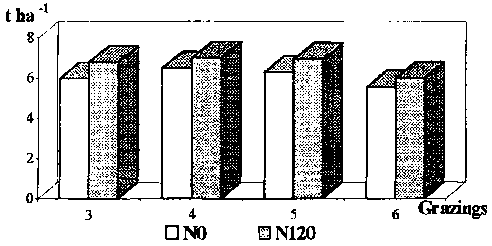Jonas Gutauskas
Lithuanian Institute of Agriculture,
Dotnuva-Akademija, Kedainiai Distr., 5051 Lithuania
Introduction
Materials and methods
Results and discussion
Conclusions
References
The aim of the trials, conducted from 1980 to 1994, was to determine the potential of white clover in mixed grass/clover swards within differing grazing frequencies, using dairy cattle, and annual rates of fertilizer N application. The long-term nature of the trials gave an opportunity to measure the stability of the clover contribution and the variation in sward botanical composition.
The overproduction of animal products within the EC has stimulated interest in extensive management systems. These factors have resulted in increased interest in the use of white clover as a forage legume in many European countries. Grass/clover swards have a major role to play in sustainable and environmentally friendly animal production form (Frame et al, 1992; Kristensen and Kristensen, 1993). Long-term productivity, high forage quality and edibility, low inputs for N fertilizer makes white clover a highly effective in grassland (Frame and Newbould, 1986; Gutauskas, 1995).
The sward was sown in 1979 on reestablished pasture. The seed mixture was sown into oat-vetch (100 + 50 kg ha-1) cover crops for green forage. Seed mixture of pasture sward consisted of Lithuanian-bred white clover (Trifolium repens L.) Atoliai 3 kg ha-1, timothy (Phleum pratense L.) Gintaras II 8 kg ha-1, bent grass (Agrostis stolonifera L.) Ziede 3 kg ha-1 and meadow grass (Poa pratensis L.) Danga 3 kg ha-1. The soil-gleyed sandy loam The content of humus was 2.6-3.5%, pHKCl - 6.6-6.7, available P2O5 - 148-292 and K2O - 107-211 mg kg-1. Plot size was 50 m2 and there were four replications. The trials were carried out m two stages: 1980-1984 the optimum grazing regime and N fertilization for white clover productivity and persistence was determined. In the second stage of trials (1985-1994) the long-term productivity of grass/white clover swards was assessed under the optimum grazing regime as well as the influence of N fertilizer aftereffect. The sward was fertilised with 60 kg P ha-1 and 60 kg K ha-1 each year.
The optimum regime was 4-5 grazings without N application (Figure 1). The annual yield responses to N application ranged from 3.8 to 5.4 kg DM per kg of applied N, which were economically inefficient. These values are within the range cited by Frame and Newbould (1986). The grass/white clover sward gave stable DM yields of 6.2-6.4 t ha-1 which was equivalent to the productivity of grass swards receiving 240 N ha-1 annually.
In the second stage of the trials (1985-1994) the grass/white clover swards consistently yielded between 6.41 and 6.76 t DM ha-1 annually without N application (Figure 2). A stable phytocoenosis of white clover-grasses was formed. White clover average content ranged from 31.0 to 37.5% on a DM basis (Figure 3). The variation in botanical composition was predetermined by the influence of integrated meteorological conditions and symbiotic-competitive development cycle of white clover-grasses.
Termination of N application in the second stage of experiments did not produce any significant effect on the sward productivity. However it had a positive effect on the spread of white clover in the sward (Figure 3). In the 15th year of the pasture utilization a sward with a favourable botanical composition was formed which consisted of: 44.8-56.5% grasses; 21.1-31.5% white clover; 17.5-26.2% forbs on a DM basis (Figure 3).
Fig. 1: The influence of grazing frequencies and nitrogen fertilizer (kg ha-1 year-1) on the DM yield of grass/white clover (t ha-1) - Average data, 1980-1984

Fig. 2: The DM yield of grass/white clover pastures grazed four times per season (t ha-1)
White clover creates preconditions for the formation of long-term grazing swards. White clover Atoliai/grass swards ensure a long-term and stable productivity of a pasture. This is extremely relevant in the regions of ecological risk, where any intensive soil tillage practices are undesirable. It is most expedient to use these types of swards only for grazing i.e. at least 4 grazings per season and no N application.
FRAME, J. and NEWBOULD, P. (1986). Agronomy of white clover. Advances in Agronomy, 40, 1-88.
FRAME, J., BAX, J., BRYDEN, G. (1992). Herbage quality of perennial ryegrass/white clover and N-fertilized ryegrass swards in intensively managed dairy systems. Proceedings of the 14th General Meeting of the European Grassland Federation, Lahti, Finland, pp. 180-184.
GUTAUSKAS, J. (1995). Baltieji dobilai 'Atoliai' ilgalaikiuose ganykliniuose zolynuose. Lietuvos Zemdirbystes Instituto Mokslo Darbai, 43, pp. 84-91.
KRISTENSEN, I. S., KRISTENSEN, T. (1993). Management of grass/clover continuously grazed with dairy cows. White clover in Europe: State of the Art. REUR technical series. 29. pp. 37-47.